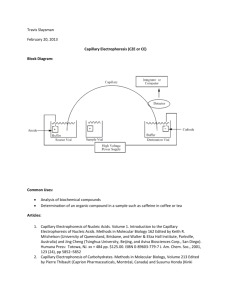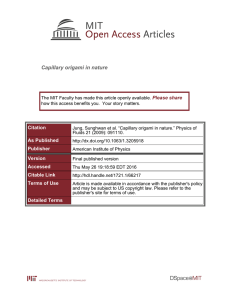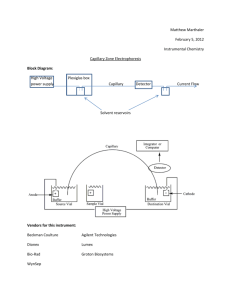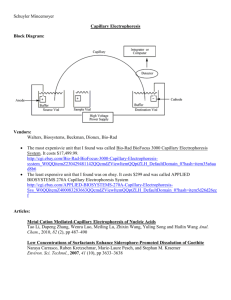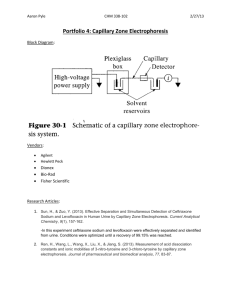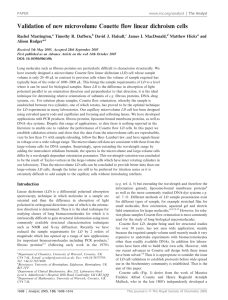Document 12970174
advertisement
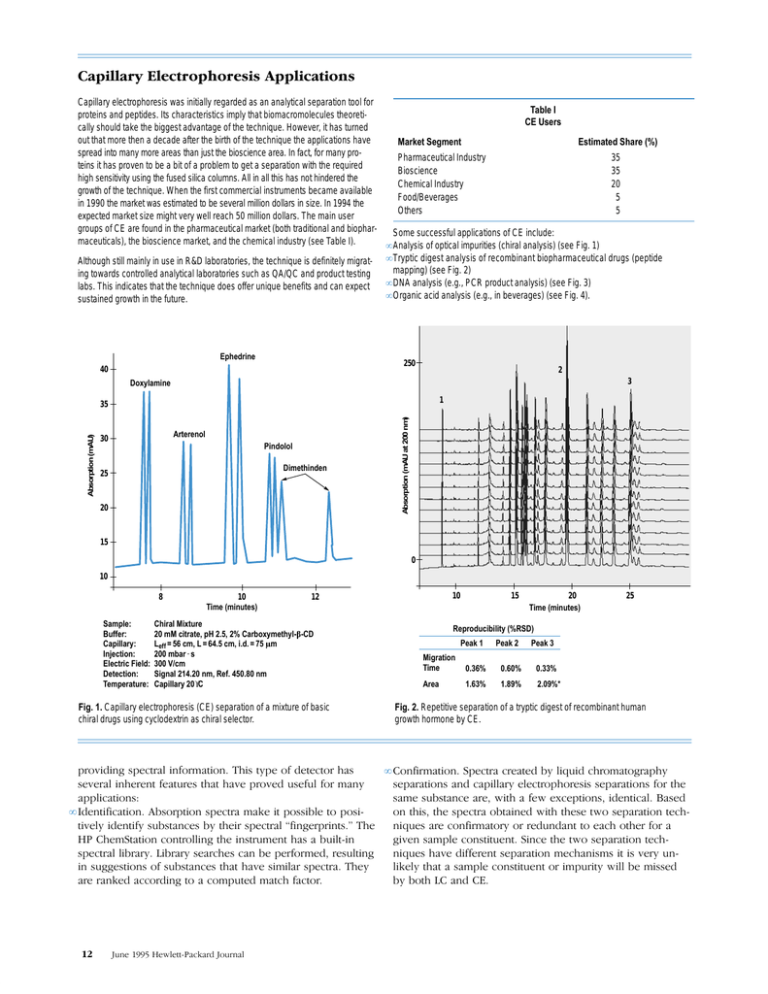
Capillary electrophoresis was initially regarded as an analytical separation tool for
Table I
proteins and peptides. Its characteristics imply that biomacromolecules theoretiCE Users
cally should take the biggest advantage of the technique. However, it has turned
out that more then a decade after the birth of the technique the applications have
Market Segment
Estimated Share (%)
spread into many more areas than just the bioscience area. In fact, for many proPharmaceutical Industry
35
teins it has proven to be a bit of a problem to get a separation with the required
Bioscience
35
high sensitivity using the fused silica columns. All in all this has not hindered the
Chemical Industry
20
growth of the technique. When the first commercial instruments became available
Food/Beverages
5
in 1990 the market was estimated to be several million dollars in size. In 1994 the
Others
5
expected market size might very well reach 50 million dollars. The main user
groups of CE are found in the pharmaceutical market (both traditional and biopharSome successful applications of CE include:
maceuticals), the bioscience market, and the chemical industry (see Table I).
• Analysis of optical impurities (chiral analysis) (see Fig. 1)
Although still mainly in use in R&D laboratories, the technique is definitely migrat- • Tryptic digest analysis of recombinant biopharmaceutical drugs (peptide
mapping) (see Fig. 2)
ing towards controlled analytical laboratories such as QA/QC and product testing
• DNA analysis (e.g., PCR product analysis) (see Fig. 3)
labs. This indicates that the technique does offer unique benefits and can expect
• Organic acid analysis (e.g., in beverages) (see Fig. 4).
sustained growth in the future.
Ephedrine
250
40
2
3
Doxylamine
1
Arterenol
30
Pindolol
Dimethinden
25
20
Absorption (mAU at 200 nm)
Absorption (mAU)
35
15
0
10
8
Sample:
Buffer:
Capillary:
Injection:
Electric Field:
Detection:
Temperature:
10
Time (minutes)
10
12
Chiral Mixture
20 mM citrate, pH 2.5, 2% Carboxymethyl--CD
Leff = 56 cm, L = 64.5 cm, i.d. = 75 m
200 mbars
300 V/cm
Signal 214.20 nm, Ref. 450.80 nm
Capillary 20°C
Fig. 1. Capillary electrophoresis (CE) separation of a mixture of basic
chiral drugs using cyclodextrin as chiral selector.
15
20
Time (minutes)
25
Reproducibility (%RSD)
Peak 1
Peak 2
Peak 3
Migration
Time
0.36%
0.60%
0.33%
Area
1.63%
1.89%
2.09%*
Fig. 2. Repetitive separation of a tryptic digest of recombinant human
growth hormone by CE.
"$!( %"&$ !$&! % &+" ! &&!$ %
• ! $&! "&$ $& + #' $!&!$"+
%($ $ & &'$% && ( "$!( '%' !$ +
%"$&! % "$+ &$!"!$%% %"$&! % !$ &
""&! %
% %'%& $ )& ) *"&! % & %
• &&! %!$"&! %"&$ & "!%% &! "!%! &% & %"&$ !& )& &% &)! %"$&! &&(+ &+ %'%& % + &$ %"&$ , $"$ &% #'% $ ! $&!$+ !$ $' & &! !&$ !$ &&! ! &$! & %&$' & % '&-
( %" ! %&&' & & &)! %"$&! &%"&$ $$+ $$+ %$% "$!$ $%'& #'% ( $ & %"$&! %% & % ($+ ' %'%&! % ! %'%& % && ( %$ %"&$ +
+ && %" ! %&&' & !$ "'$&+ ) %%
$ $ !$ &! !"'& & &!$
+ !& ' )&&-$ !'$ 220 bp Standard
Absorption (mAU)
pBR328-Hinf 1
1.5% LPA, 6% LPA-coated
TBE pH 8.3
20 kV, 13 A
Leff = 5.6 cm, i.d. =75 m, BF = 3
Inj: –10 kV, 3 s
260 nm (Ref 350 nm)
Capillary: 25C
Carousel: 10C
222 bp Product
5
6
7
8
9
Time (minutes)
10
11
min
Fig. 3. Separation of PCR products using capillary gel electrophoresis.
Table II
CE Applications and Benefits
Chiral Analysis
Peptide Mapping
DNA Analysis
Other Analysis Methods
HPLC, GC, TLC, SFC
HPLC
CE Benefits
Speed
Easy Method Development
Cost of Analysis
80
70
Speed
Orthogonal Mechanism
Slab Gel Electrophoresis,
HPLC
Superior Resolution
Speed
Online Quantitation
All of these applications have in common that CE offers significant benefits over
previously existing techniques (see Table II).
The future outlook for CE is positive although further development of capillaries
suitable for protein analysis under native conditions and the development of other
detection modules such as CE-MS will be important for long-term establishment of
the technique.
Martin L. Verhoef
Product Manager
Waldbronn Analytical Division
David N. Heiger
Application Chemist
Analytical Marketing Center, Little Falls
• *'). (*'"#) ) )) (%)'*" (
')'() $' ')# (*()# # *( )$ "(*'
% %*'). ) (%)' ("%! !$# ) % ' #0
)! ) % # ((*" )$ %*' ) (%)'
# !$# ) % ($# (*()# ") +
$!*)
+# )$* $ ''. ))$# ( ('! )*' )
,$*! *#%)! ) (#()+). ,' #$) $"%))+
,) $#+#)$#! ( ))$'( (* ( (#!0,+!#)
))$'( $' +'! ,+!#) ))$'( , ,$' ,)
!)' ,!( #%(( !)'( $' '$))# "$#$'$")$'
')#( )*( %'$+# (&*#)! (%)' ,)( #
' #'#)!. ("!!' )# # )" # . (### +'! ,+!#) ))$' $' (### )'$*
Citric
Tartaric
60
Absorption (mAU)
Application
Malic
Lactic
50
40
Succinic
Acetic
30
20
10
0
2
3
4
5
6
Time (minutes)
7
8
9
Buffer:
5 mM phthalate, 0.25 mM CTAC, 0.07% -CD, pH 3.5
Sample:
Sake (diluted 1:5 with water)
Capillary:
Leff = 56 cm, L = 64.5 cm, i.d. = 75 m
Injection:
200 mbars
Temperature: 15C
Field Strength: 390 V/cm, Reversed Polarity
Fig. 4. Analysis of organic acids in sake employing indirect UV detection.
) *!! (%)'! '# ##$) #!) ( " ( )(
))$'( !(( %''! $' (%)'! #))$# # %!!'.
!)'$%$'(( $,+' ) (#()+). $ "$#$'$")$'0
( ))$'( ( +, ( ) ()) $ ) ') # $ $)# ) (" !+! $ (#()+). ,) ) $ ''.
( (%)'$")' $ ) (.()" (%! ' ,(
+# )$ ) $%)! (# $ ) ))$' ( ('
# "$' )! # ) ')! $# % ) $)+ ,( )$
$%)"/ ) !) )'$*%*) # )'$' ) !) ##)
$#)$ ) %$)$$( , )'"#( ) !$,() #$(
!+! +! ,) # $%)! ))$' $ "-"/ ,' ( ) #'"#)! ($'%)$# # # ( )
#'"#)! $##)')$# # $ ) !* '(# # )
$%)! %) !! !) ")) . ) !"% ( $*( $#)$ )
*# ,!))0 ' $*'#!



